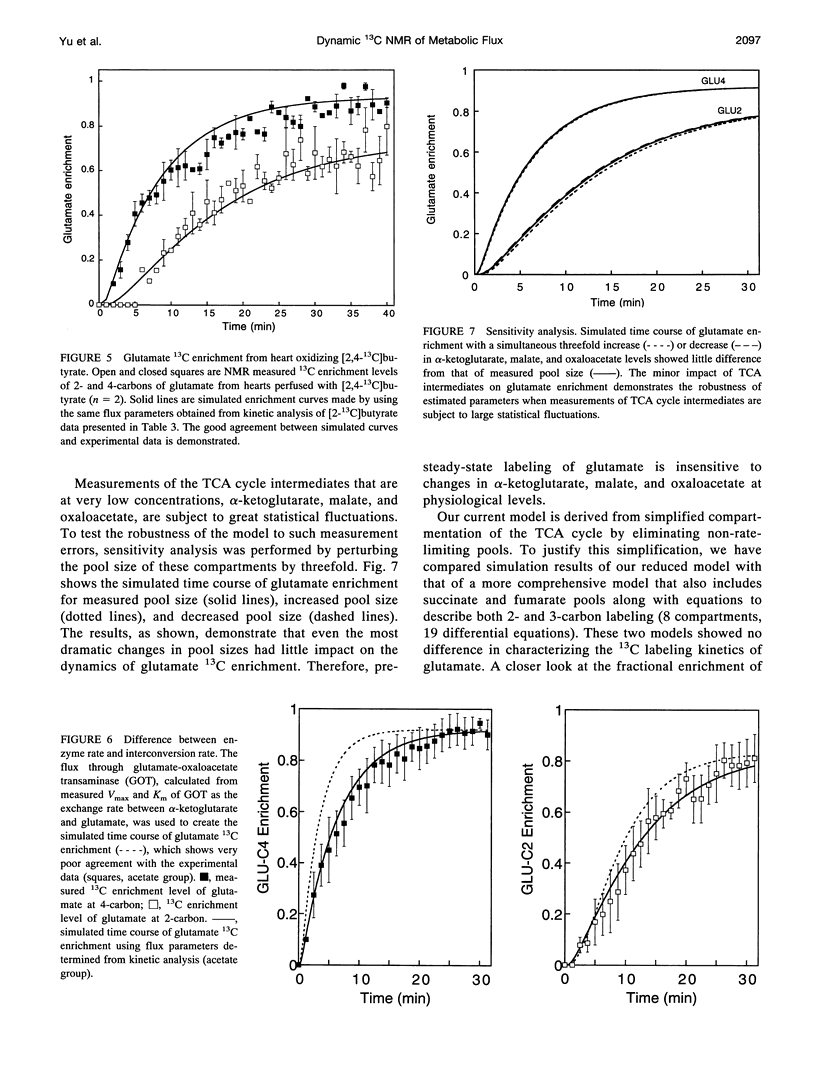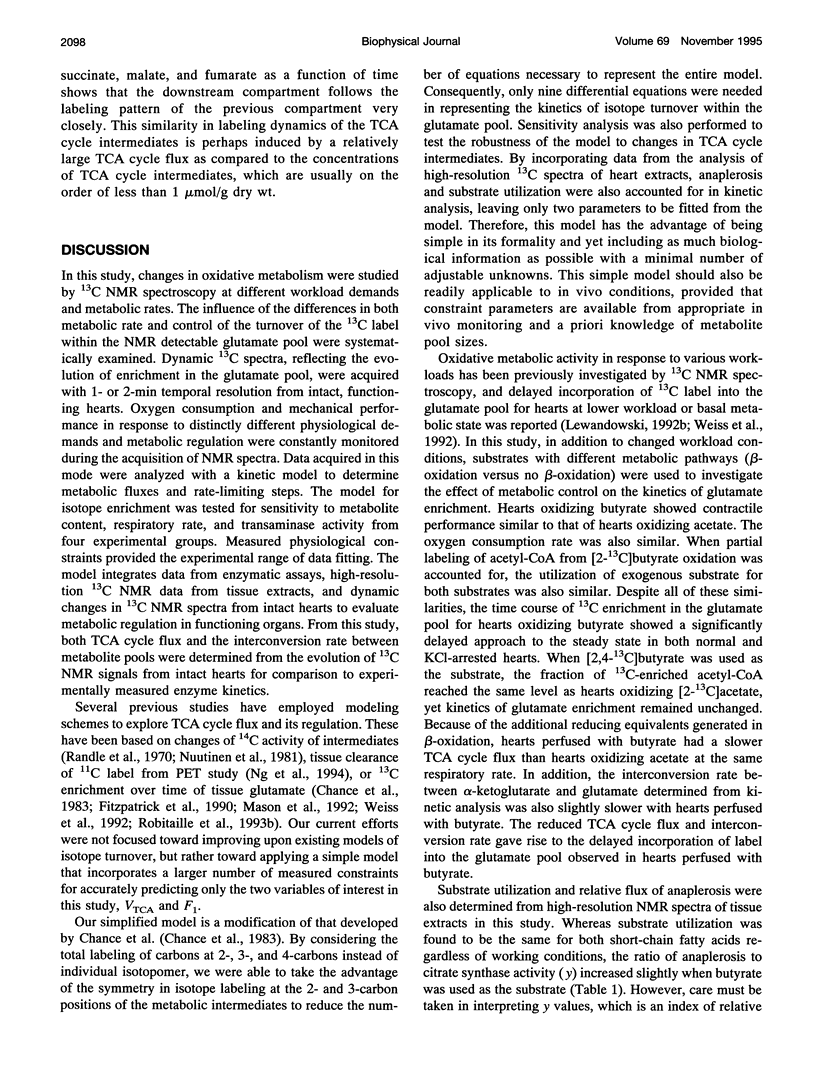Abstract
Control of oxidative metabolism was studied using 13C NMR spectroscopy to detect rate-limiting steps in 13C labeling of glutamate. 13C NMR spectra were acquired every 1 or 2 min from isolated rabbit hearts perfused with either 2.5 mM [2-13C]acetate or 2.5 mM [2-13C]butyrate with or without KCl arrest. Tricarboxylic acid cycle flux (VTCA) and the exchange rate between alpha-ketoglutarate and glutamate (F1) were determined by least-square fitting of a kinetic model to NMR data. Rates were compared to measured kinetics of the cardiac glutamate-oxaloacetate transaminase (GOT). Despite similar oxygen use, hearts oxidizing butyrate instead of acetate showed delayed incorporation of 13C label into glutamate and lower VTCA, because of the influence of beta-oxidation: butyrate = 7.1 +/- 0.2 mumol/min/g dry wt; acetate = 10.1 +/- 0.2; butyrate + KCl = 1.8 +/- 0.1; acetate + KCl = 3.1 +/- 0.1 (mean +/- SD). F1 ranged from a low of 4.4 +/- 1.0 mumol/min/g (butyrate + KCl) to 9.3 +/- 0.6 (acetate), at least 20-fold slower than GOT flux, and proved to be rate limiting for isotope turnover in the glutamate pool. Therefore, dynamic 13C NMR observations were sensitive not only to TCA cycle flux but also to the interconversion between TCA cycle intermediates and glutamate.
Full text
PDF












Selected References
These references are in PubMed. This may not be the complete list of references from this article.
- Bailey I. A., Gadian D. G., Matthews P. M., Radda G. K., Seeley P. J. Studies of metabolism in the isolated, perfused rat heart using 13C NMR. FEBS Lett. 1981 Jan 26;123(2):315–318. doi: 10.1016/0014-5793(81)80317-1. [DOI] [PubMed] [Google Scholar]
- Berkich D. A., Williams G. D., Masiakos P. T., Smith M. B., Boyer P. D., LaNoue K. F. Rates of various reactions catalyzed by ATP synthase as related to the mechanism of ATP synthesis. J Biol Chem. 1991 Jan 5;266(1):123–129. [PubMed] [Google Scholar]
- Bittl J. A., Ingwall J. S. Reaction rates of creatine kinase and ATP synthesis in the isolated rat heart. A 31P NMR magnetization transfer study. J Biol Chem. 1985 Mar 25;260(6):3512–3517. [PubMed] [Google Scholar]
- Chacon E., Reece J. M., Nieminen A. L., Zahrebelski G., Herman B., Lemasters J. J. Distribution of electrical potential, pH, free Ca2+, and volume inside cultured adult rabbit cardiac myocytes during chemical hypoxia: a multiparameter digitized confocal microscopic study. Biophys J. 1994 Apr;66(4):942–952. doi: 10.1016/S0006-3495(94)80904-X. [DOI] [PMC free article] [PubMed] [Google Scholar]
- Chance E. M., Seeholzer S. H., Kobayashi K., Williamson J. R. Mathematical analysis of isotope labeling in the citric acid cycle with applications to 13C NMR studies in perfused rat hearts. J Biol Chem. 1983 Nov 25;258(22):13785–13794. [PubMed] [Google Scholar]
- Chatham J. C., Forder J. R., Glickson J. D., Chance E. M. Calculation of absolute metabolic flux and the elucidation of the pathways of glutamate labeling in perfused rat heart by 13C NMR spectroscopy and nonlinear least squares analysis. J Biol Chem. 1995 Apr 7;270(14):7999–8008. doi: 10.1074/jbc.270.14.7999. [DOI] [PubMed] [Google Scholar]
- Dean E. N., Shlafer M., Nicklas J. M. The oxygen consumption paradox of "stunned myocardium" in dogs. Basic Res Cardiol. 1990 Mar-Apr;85(2):120–131. doi: 10.1007/BF01906965. [DOI] [PubMed] [Google Scholar]
- Fahien L. A., Strmecki M. Studies of gluconeogenic mitochondrial enzymes. 3. The conversion of alpha-ketoglutarate to glutamate by bovine liver mitochondrial glutamate dehydrogenase and glutamate-oxaloacetate transaminase. Arch Biochem Biophys. 1969 Mar;130(1):468–477. doi: 10.1016/0003-9861(69)90059-9. [DOI] [PubMed] [Google Scholar]
- Fahien L. A., Strmecki M. Studies on gluconeogenic mitochondrial enzymes. II. The conversion of glutamate to alpha-ketoglutarate by bovine liver mitochondrial glutamate dehydrogenase and glutamate-oxaloacetate transaminase. Arch Biochem Biophys. 1969 Mar;130(1):456–467. doi: 10.1016/0003-9861(69)90058-7. [DOI] [PubMed] [Google Scholar]
- Fitzpatrick S. M., Hetherington H. P., Behar K. L., Shulman R. G. The flux from glucose to glutamate in the rat brain in vivo as determined by 1H-observed, 13C-edited NMR spectroscopy. J Cereb Blood Flow Metab. 1990 Mar;10(2):170–179. doi: 10.1038/jcbfm.1990.32. [DOI] [PubMed] [Google Scholar]
- Hutson S. M., Williams G. D., Berkich D. A., LaNoue K. F., Briggs R. W. A 31P NMR study of mitochondrial inorganic phosphate visibility: effects of Ca2+, Mn2+, and the pH gradient. Biochemistry. 1992 Feb 11;31(5):1322–1330. doi: 10.1021/bi00120a007. [DOI] [PubMed] [Google Scholar]
- Idell-Wenger J. A., Grotyohann L. W., Neely J. R. Coenzyme A and carnitine distribution in normal and ischemic hearts. J Biol Chem. 1978 Jun 25;253(12):4310–4318. [PubMed] [Google Scholar]
- Kelleher J. K. Analysis of tricarboxylic acid cycle using [14C]citrate specific activity ratios. Am J Physiol. 1985 Feb;248(2 Pt 1):E252–E260. doi: 10.1152/ajpendo.1985.248.2.E252. [DOI] [PubMed] [Google Scholar]
- Kobayashi K., Neely J. R. Control of maximum rates of glycolysis in rat cardiac muscle. Circ Res. 1979 Feb;44(2):166–175. doi: 10.1161/01.res.44.2.166. [DOI] [PubMed] [Google Scholar]
- LaNoue K. F., Bryla J., Bassett D. J. Energy-driven aspartate efflux from heart and liver mitochondria. J Biol Chem. 1974 Dec 10;249(23):7514–7521. [PubMed] [Google Scholar]
- LaNoue K. F., Schoolwerth A. C. Metabolite transport in mitochondria. Annu Rev Biochem. 1979;48:871–922. doi: 10.1146/annurev.bi.48.070179.004255. [DOI] [PubMed] [Google Scholar]
- LaNoue K. F., Walajtys E. I., Williamson J. R. Regulation of glutamate metabolism and interactions with the citric acid cycle in rat heart mitochondria. J Biol Chem. 1973 Oct 25;248(20):7171–7183. [PubMed] [Google Scholar]
- LaNoue K. F., Williamson J. R. Interrelationships between malate-aspartate shuttle and citric acid cycle in rat heart mitochondria. Metabolism. 1971 Feb;20(2):119–140. doi: 10.1016/0026-0495(71)90087-4. [DOI] [PubMed] [Google Scholar]
- LaNoue K., Nicklas W. J., Williamson J. R. Control of citric acid cycle activity in rat heart mitochondria. J Biol Chem. 1970 Jan 10;245(1):102–111. [PubMed] [Google Scholar]
- Lewandowski E. D., Chari M. V., Roberts R., Johnston D. L. NMR studies of beta-oxidation and short-chain fatty acid metabolism during recovery of reperfused hearts. Am J Physiol. 1991 Aug;261(2 Pt 2):H354–H363. doi: 10.1152/ajpheart.1991.261.2.H354. [DOI] [PubMed] [Google Scholar]
- Lewandowski E. D., Hulbert C. Dynamic changes in 13C NMR spectra of intact hearts under conditions of varied metabolite enrichment. Magn Reson Med. 1991 May;19(1):186–190. doi: 10.1002/mrm.1910190118. [DOI] [PubMed] [Google Scholar]
- Lewandowski E. D., Johnston D. L. Reduced substrate oxidation in postischemic myocardium: 13C and 31P NMR analyses. Am J Physiol. 1990 May;258(5 Pt 2):H1357–H1365. doi: 10.1152/ajpheart.1990.258.5.H1357. [DOI] [PubMed] [Google Scholar]
- Lewandowski E. D., Johnston D. L., Roberts R. Effects of inosine on glycolysis and contracture during myocardial ischemia. Circ Res. 1991 Feb;68(2):578–587. doi: 10.1161/01.res.68.2.578. [DOI] [PubMed] [Google Scholar]
- Lewandowski E. D. Metabolic heterogeneity of carbon substrate utilization in mammalian heart: NMR determinations of mitochondrial versus cytosolic compartmentation. Biochemistry. 1992 Sep 22;31(37):8916–8923. doi: 10.1021/bi00152a031. [DOI] [PubMed] [Google Scholar]
- Lewandowski E. D. Nuclear magnetic resonance evaluation of metabolic and respiratory support of work load in intact rabbit hearts. Circ Res. 1992 Mar;70(3):576–582. doi: 10.1161/01.res.70.3.576. [DOI] [PubMed] [Google Scholar]
- Malloy C. R., Sherry A. D., Jeffrey F. M. Carbon flux through citric acid cycle pathways in perfused heart by 13C NMR spectroscopy. FEBS Lett. 1987 Feb 9;212(1):58–62. doi: 10.1016/0014-5793(87)81556-9. [DOI] [PubMed] [Google Scholar]
- Malloy C. R., Sherry A. D., Jeffrey F. M. Evaluation of carbon flux and substrate selection through alternate pathways involving the citric acid cycle of the heart by 13C NMR spectroscopy. J Biol Chem. 1988 May 25;263(15):6964–6971. [PubMed] [Google Scholar]
- Masiakos P. T., Williams G. D., Berkich D. A., Smith M. B., LaNoue K. F. 31P NMR saturation-transfer study of the in situ kinetics of the mitochondrial adenine nucleotide translocase. Biochemistry. 1991 Aug 27;30(34):8351–8357. doi: 10.1021/bi00098a011. [DOI] [PubMed] [Google Scholar]
- Mason G. F., Rothman D. L., Behar K. L., Shulman R. G. NMR determination of the TCA cycle rate and alpha-ketoglutarate/glutamate exchange rate in rat brain. J Cereb Blood Flow Metab. 1992 May;12(3):434–447. doi: 10.1038/jcbfm.1992.61. [DOI] [PubMed] [Google Scholar]
- Michuda C. M., Martinez-Carrion M. The isozymes of glutamate-aspartate transaminase. Mechanism of inhibition of dicarboxylic acids. J Biol Chem. 1970 Jan 25;245(2):262–269. [PubMed] [Google Scholar]
- Neely J. R., Liebermeister H., Battersby E. J., Morgan H. E. Effect of pressure development on oxygen consumption by isolated rat heart. Am J Physiol. 1967 Apr;212(4):804–814. doi: 10.1152/ajplegacy.1967.212.4.804. [DOI] [PubMed] [Google Scholar]
- Ng C. K., Huang S. C., Schelbert H. R., Buxton D. B. Validation of a model for [1-11C]acetate as a tracer of cardiac oxidative metabolism. Am J Physiol. 1994 Apr;266(4 Pt 2):H1304–H1315. doi: 10.1152/ajpheart.1994.266.4.H1304. [DOI] [PubMed] [Google Scholar]
- Nuutinen E. M., Peuhkurinen K. J., Pietiläinen E. P., Hiltunen J. K., Hassinen I. E. Elimination and replenishment of tricarboxylic acid-cycle intermediates in myocardium. Biochem J. 1981 Mar 15;194(3):867–875. doi: 10.1042/bj1940867. [DOI] [PMC free article] [PubMed] [Google Scholar]
- Peuhkurinen K. J., Hassinen I. E. Pyruvate carboxylation as an anaplerotic mechanism in the isolated perfused rat heart. Biochem J. 1982 Jan 15;202(1):67–76. doi: 10.1042/bj2020067. [DOI] [PMC free article] [PubMed] [Google Scholar]
- Peuhkurinen K. J. Regulation of the tricarboxylic acid cycle pool size in heart muscle. J Mol Cell Cardiol. 1984 Jun;16(6):487–495. doi: 10.1016/s0022-2828(84)80637-9. [DOI] [PubMed] [Google Scholar]
- Randle P. J., England P. J., Denton R. M. Control of the tricarboxylate cycle and its interactions with glycolysis during acetate utilization in rat heart. Biochem J. 1970 May;117(4):677–695. doi: 10.1042/bj1170677. [DOI] [PMC free article] [PubMed] [Google Scholar]
- Robitaille P. M., Rath D. P., Abduljalil A. M., O'Donnell J. M., Jiang Z., Zhang H., Hamlin R. L. Dynamic 13C NMR analysis of oxidative metabolism in the in vivo canine myocardium. J Biol Chem. 1993 Dec 15;268(35):26296–26301. [PubMed] [Google Scholar]
- Robitaille P. M., Rath D. P., Skinner T. E., Abduljalil A. M., Hamlin R. L. Transaminase reaction rates, transport activities and TCA cycle analysis by post-steady state 13C NMR. Magn Reson Med. 1993 Aug;30(2):262–266. doi: 10.1002/mrm.1910300218. [DOI] [PubMed] [Google Scholar]
- Russell R. R., 3rd, Taegtmeyer H. Changes in citric acid cycle flux and anaplerosis antedate the functional decline in isolated rat hearts utilizing acetoacetate. J Clin Invest. 1991 Feb;87(2):384–390. doi: 10.1172/JCI115008. [DOI] [PMC free article] [PubMed] [Google Scholar]
- STRISOWER E. H., KOHLER G. D., CHAIKOFF I. L. Incorporation of acetate carbon into glucose by liver slices from normal and alloxan-diabetic rats. J Biol Chem. 1952 Sep;198(1):115–126. [PubMed] [Google Scholar]
- Safer B. The Metabolic Significance of the Malate-Aspartate Cycle in Heart. Circ Res. 1975 Nov;37(5):527–533. doi: 10.1161/01.res.37.5.527. [DOI] [PubMed] [Google Scholar]
- Sherry A. D., Sumegi B., Miller B., Cottam G. L., Gavva S., Jones J. G., Malloy C. R. Orientation-conserved transfer of symmetric Krebs cycle intermediates in mammalian tissue. Biochemistry. 1994 May 24;33(20):6268–6275. doi: 10.1021/bi00186a029. [DOI] [PubMed] [Google Scholar]
- Soboll S., Elbers R., Scholz R., Heldt H. W. Subcellular distribution of di- and tricarboxylates and pH gradients in perfused rat liver. Hoppe Seylers Z Physiol Chem. 1980 Jan;361(1):69–76. doi: 10.1515/bchm2.1980.361.1.69. [DOI] [PubMed] [Google Scholar]
- Taegtmeyer H. On the inability of ketone bodies to serve as the only energy providing substrate for rat heart at physiological work load. Basic Res Cardiol. 1983 Jul-Aug;78(4):435–450. doi: 10.1007/BF02070167. [DOI] [PubMed] [Google Scholar]
- Tischler M. E., Pachence J., Williamson J. R., La Noue K. F. Mechanism of glutamate-aspartate translocation across the mitochondrial inner membrane. Arch Biochem Biophys. 1976 Apr;173(2):448–461. doi: 10.1016/0003-9861(76)90282-4. [DOI] [PubMed] [Google Scholar]
- WEINMAN E. O., STRISOWER E. H., CHAIKOFF I. L. Conversion of fatty acids to carbohydrate; application of isotopes to this problem and role of the Krebs cycle as a synthetic pathway. Physiol Rev. 1957 Apr;37(2):252–272. doi: 10.1152/physrev.1957.37.2.252. [DOI] [PubMed] [Google Scholar]
- Weiss R. G., Gloth S. T., Kalil-Filho R., Chacko V. P., Stern M. D., Gerstenblith G. Indexing tricarboxylic acid cycle flux in intact hearts by carbon-13 nuclear magnetic resonance. Circ Res. 1992 Feb;70(2):392–408. doi: 10.1161/01.res.70.2.392. [DOI] [PubMed] [Google Scholar]
- Weiss R. G., Stern M. D., de Albuquerque C. P., Vandegaer K., Chacko V. P., Gerstenblith G. Consequences of altered aspartate aminotransferase activity on 13C-glutamate labelling by the tricarboxylic acid cycle in intact rat hearts. Biochim Biophys Acta. 1995 Apr 13;1243(3):543–548. doi: 10.1016/0304-4165(95)00031-6. [DOI] [PubMed] [Google Scholar]


